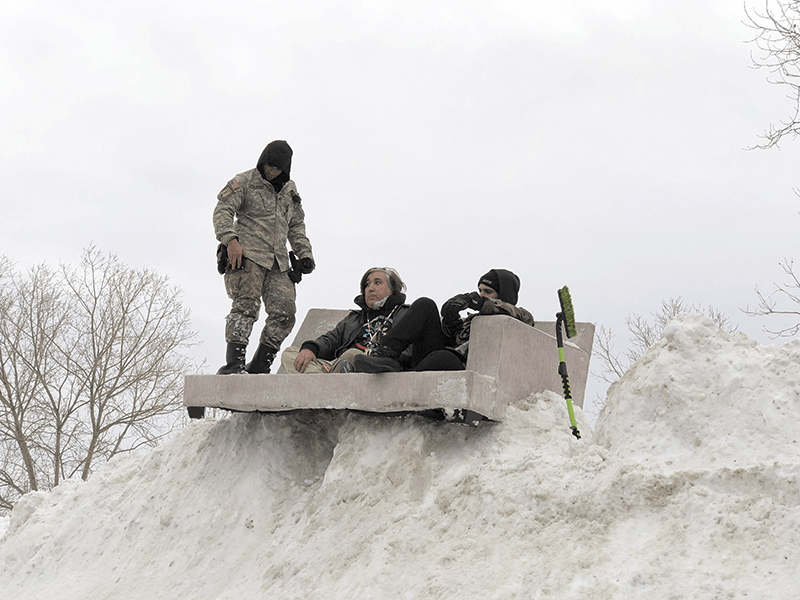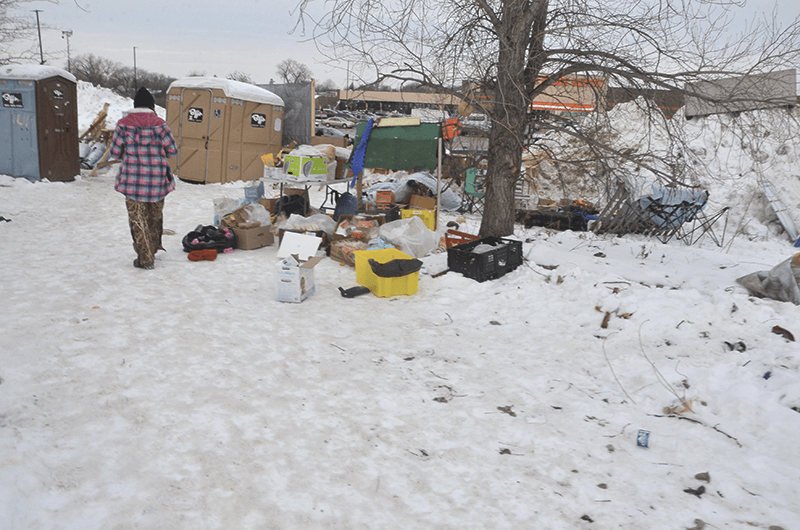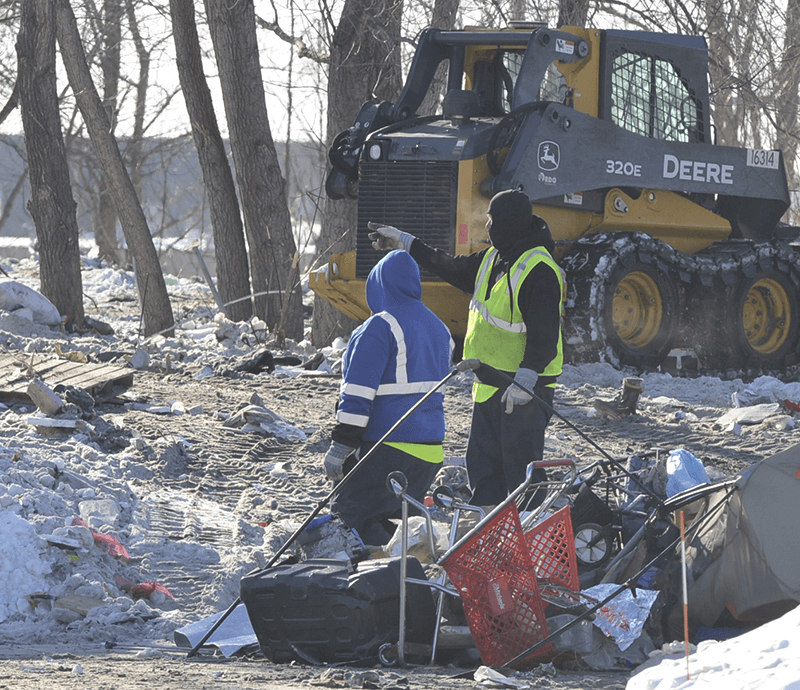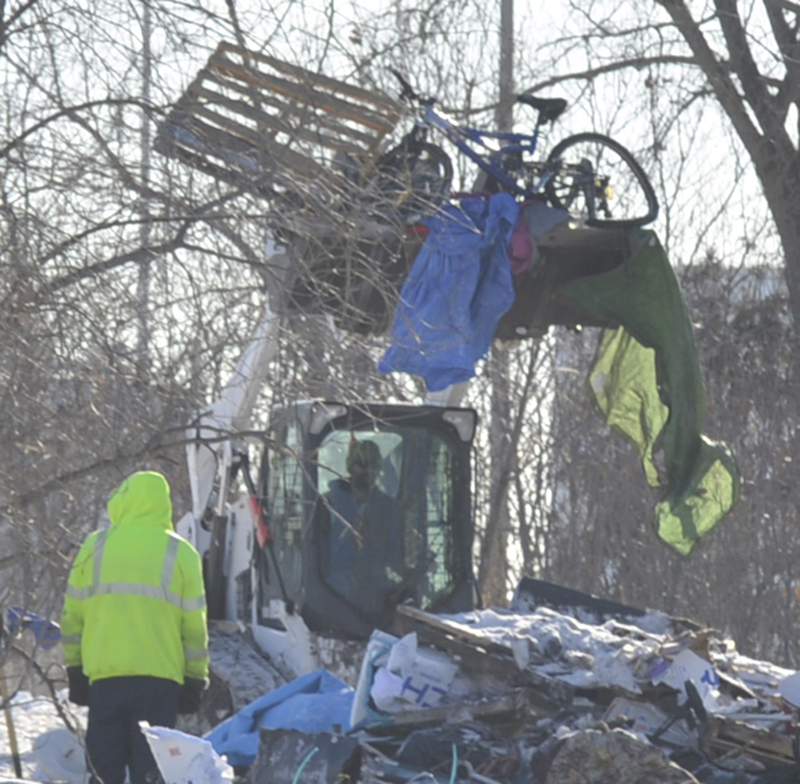Young Eagle slid down a snowbank and landed on the wet asphalt, losing his shoe. A former resident of the Quarry shopping center homeless encampment, he was eager to talk to a Northeaster reporter. He was there, he said, to support his friends.
The city of Minneapolis had announced they were going to clear the encampment at 9:30 a.m. Wednesday, Dec. 28. Young Eagle and two of his friends had posted a lookout atop what remained of a sofa perched on a snowbank near the camp entrance. Nearby were members of Communities United Against Police Brutality. TV cameramen chatted with each other in the parking lot a few yards away. Everyone watched anxiously for the arrival of Public Works employees and the police.
Young Eagle said he wanted to make sure people “get food, water, things like that.” Supporters, he said, are “self-organizing, a community organizing together, working together without having a board [of directors] like at a 501(c)3. We just reach out and directly help people. Some people dig into their own pockets; others are out fundraising and starting internet campaigns. There’s been talk of doing some door-knocking campaigns, not just to raise funds, but to raise awareness [of homelessness] and counter harmful narratives that the homeless are lazy, they’re all on drugs.”
Young Eagle has made the camp his home two or three times; he moved into shelter two months ago. He said he had lived in “horrific conditions” in the past two years – “in tents in squalid conditions, gale-force winds.”
He said people have a misconception about camp residents, that they’re dangerous and violent. “I’ve seen people helping each other out,” he said. “‘Do you need propane?’ ‘Do you need a snack, water?’ As far as [drug] usage,” he said, “I challenge anyone to live here a couple of months and tell me you don’t want to grab a brandy bottle or something.”
Young Eagle was approached by a man wearing a stethoscope, who said his nickname was “Irish.” He’s a nurse at one of the Twin Cities’ major hospitals and has spent the past 20 years serving the homeless as a “street medic.” He was motivated to care for people on the street after the 2004 Republican Convention in New York City, when police made mass arrests of peaceful protesters. “I got tired of seeing police thumping people over and over and over again,” he said.
He said he has treated people in camps throughout the metropolitan area. It was his first visit to the Quarry camp; he answered a call put out by a group of EMTs. He said he has provided wound treatment for people with diabetes and he works with the homeless to help them find medical assistance.
“The city and the mayor’s office have said people here were offered a place to go to but refused to leave,” Irish said. “I don’t believe them.”
Young Eagle replied, “Some people have move-in dates, which is why it doesn’t make any sense to evict [them from] this place.”
“The media is flat-out lying,” said Irish. “They’re saying there are beds available. There are no beds available. People in city hall are saying they’re offering places for people to go, and they’re lying. A place like Dorothy Day in St. Paul is unsafe. People are getting assaulted there all the time, sexually or otherwise. You don’t want to go to an unsafe place. That’s why people end up in a place like this.” He gestured toward the camp behind him.
As the morning wore on, it became apparent that no one was coming to move the camp residents. One TV crew packed up its gear and left.
The Northeaster contacted the Minneapolis Police Department for an update and was redirected to the city’s communications office.
Sarah McKenzie, Minneapolis Communications, said in an email, “There is a precedent for protesters to have violent clashes with city staff at encampment closures. City employees have sustained injuries in the past. So the city decided to pursue a delay out of an abundance of caution given the sizeable amount of protesters on site early in the morning.”
We counted no more than 20 protesters around 10:30 a.m., and no more than ten throughout the afternoon.
Northeaster reporters kept their own vigil throughout the day at the camp, which sat on the grassy area on the south edge of the Home Depot/Quarry parking lot.
The encampment area had an upward- sloped entrance about 20 feet wide, bordered by ten-foot-high snow walls, made from the parking lot snow plowed to the edges. At the top of the slope was a portable toilet, with wooden pallets on each side set on edges for a makeshift fence. A six-foot square canvas with the words “STOP THE SWEEPS – NO EVICTIONS ON STOLEN LAND” stood at the edge of the parking lot with six city-supplied residential trash containers. A second cardboard sign said, “Defend PPL with our lives. They all matter,” and a third said, “Bulldozers are bastards.”
A woman with a walkie-talkie stood near the entrance, allowing only a chosen few to enter the camp.
Camp supporters came and went throughout the day. At 12:30, a Domino’s Pizza delivery person took four pizzas into the encampment, returned with a sheet of paper and left. Ten minutes later, a large Minneapolis Public Works truck stopped briefly at the entrance, then moved on to the lot exit.
Shortly before 2 p.m., a black SUV with doors that said “Assured Security” backed up about 100 feet east of the entrance; the driver remained inside. The SUV left at about 2:30 p.m.
At the same time, a Star Tribune reporter attempted to talk to the woman holding the walkie-talkie, who was now standing behind the pallet barrier – no luck. The woman left the encampment a few minutes later with a man in a black 1992 Lincoln.
At 2:15, a blue SUV arrived at the entrance, and an elderly couple emerged. The man removed two large black boxes from the rear while the woman walked into the encampment. A Northeaster reporter walked over to the man to ask about the boxes’ contents. He said he and his wife were delivering food from a food bank. A resident came down the entrance slope with a small wagon. The reporter asked the man if he needs help. They pushed the wagon with the boxes up the (slippery) slope. A young woman approached the reporter and said, “You can’t be here – people live here!” The reporter dawdled a bit, but the woman was insistent. After a few hurried photos, the reporter left the encampment. The inhabitants appeared to be settling down.
On Thursday morning, the camp entrance was barricaded with more wooden shipping pallets. Large garbage containers stood front and center, filled to the brim. A car was parked near the camp entrance. Some camp residents were getting ready to move out, with the assistance of their supporters. By nightfall, the number of waiting cars had increased. Another day passed without city interference.
On Friday morning before sun-up, the police strung “Police Line Do Not Cross” yellow tape across the middle of the Home Depot parking lot at the Quarry.
The tape, and perhaps 15 police vehicles parked at intervals, extended all the way around the homeless encampment. Dozens of other city vehicles were parked randomly in the lot.
Inside the camp, front-end loaders and other tractors scraped the former camp down to the ground.
The yellow tape created an odd juxtaposition of two different worlds at the Quarry.
On one side, the massive mechanical devices scraped the encampment bare, creating huge piles of three years’ worth of tents, mattresses, bicycles, and other rubble into huge piles. The piles were then loaded into dump trucks and hauled away.
On the other side of the yellow tape, shoppers went about their business, stocking up on home improvement gear, sometimes pausing to gaze at the large machines clearing the camp.
The front-end loaders and other machines worked on into the afternoon.
Police officers sat in their cars or moved about the parking lot. There were no protesters in late morning.
Later Friday morning, the city of Minneapolis sent a news release to the Northeaster, declaring the camp closed. “When the site was secured this morning, there were six unsheltered individuals present,” wrote Casper Hill. “All individuals declined transportation to the Catholic Charities’ Opportunity Center for support, resources, and connection to shelter and housing opportunities. Two requested and received transportation from the City to alternate locations.” The remaining four “left the site on foot and did not indicate where they were going,” Hill said. “The MPD had chaplains on site to provide additional support to unsheltered individuals during this transition.”
Young Eagle, center, a former resident of the Quarry encampment, and two of his friends wait for the police to arrive on Wednesday, Dec. 28. The city of Minneapolis held off clearing the camp for two days, saying they were deterred by the “large number” of activists. Northeaster reporters counted no more than 20. (Photo by Cynthia Sowden) A camp resident walked away from a food drop made Wednesday. (Photo by Mark Peterson) City of Minneapolis workers on Friday, Dec. 30, stand by a pile of debris that includes a shopping cart, child car chair, tent poles and pieces of tents while in the background a tractor continues to scrape the camp down to the ground. The city worked through the day to remove all traces of the camp which at one time housed about 25 people.
(Photos by Al Zdon)



